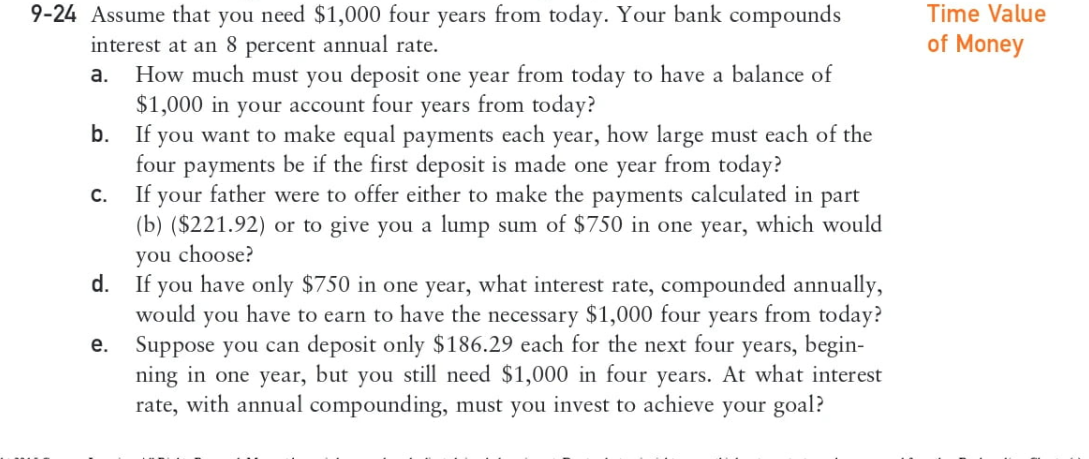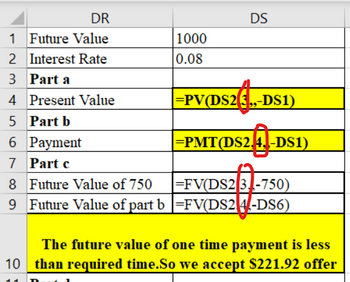Assume that you need $1,000 four years from today. Your bank compounds interest at an 8 percent annual rate. How much must you deposit one year from today to have a balance of $1,000 in your account four years from today? b. If you want to make equal payments each year, how large must each of the four payments be if the first deposit is made one year from today? c. If your father were to offer either to make the payments calculated in part (b) ($221.92) or to give you a lump sum of $750 in one year, which would you choose? d. e. If you have only $750 in one year, what interest rate, compounded annually, would you have to earn to have the necessary $1,000 four years from today? Suppose you can deposit only $186.29 each for the next four years, begin- ning in one year, but you still need $1,000 in four years. At what interest rate, with annual compounding, must you invest to achieve your goal?
Assume that you need $1,000 four years from today. Your bank compounds interest at an 8 percent annual rate. How much must you deposit one year from today to have a balance of $1,000 in your account four years from today? b. If you want to make equal payments each year, how large must each of the four payments be if the first deposit is made one year from today? c. If your father were to offer either to make the payments calculated in part (b) ($221.92) or to give you a lump sum of $750 in one year, which would you choose? d. e. If you have only $750 in one year, what interest rate, compounded annually, would you have to earn to have the necessary $1,000 four years from today? Suppose you can deposit only $186.29 each for the next four years, begin- ning in one year, but you still need $1,000 in four years. At what interest rate, with annual compounding, must you invest to achieve your goal?
Chapter4: Time Value Of Money
Section: Chapter Questions
Problem 2STP
Related questions
Question
100%
Please use excel to show your responses.

Transcribed Image Text:9-24 Assume that you need $1,000 four years from today. Your bank compounds
interest at an 8 percent annual rate.
a.
How much must you deposit one year from today to have a balance of
$1,000 in your account four years from today?
b.
If you want to make equal payments each year, how large must each of the
four payments be if the first deposit is made one year from today?
If your father were to offer either to make the payments calculated in part
(b) ($221.92) or to give you a lump sum of $750 in one year, which would
you choose?
C.
d. If you have only $750 in one year, what interest rate, compounded annually,
would you have to earn to have the necessary $1,000 four years from today?
Suppose you can deposit only $186.29 each for the next four years, begin-
ning in one year, but you still need $1,000 in four years. At what interest
rate, with annual compounding, must you invest to achieve your goal?
e.
Time Value
of Money
Expert Solution
This question has been solved!
Explore an expertly crafted, step-by-step solution for a thorough understanding of key concepts.
This is a popular solution!
Trending now
This is a popular solution!
Step by step
Solved in 2 steps with 2 images

Follow-up Questions
Read through expert solutions to related follow-up questions below.
Follow-up Question
Please show answers using excel

Transcribed Image Text:f.
To help you reach your $1,000 goal, your father offers to give you $400 in
one year. You will get a part-time job and make six additional payments of
equal amounts each six months thereafter. If all of this money is deposited in
a bank that pays 8 percent, compounded semiannually, how large must each
of the six payments be?
What is the effective annual rate being paid by the bank in part (f)?
g.
Solution
Follow-up Question
Where does the number 3 and number form highlighted on the picture comes from?

Transcribed Image Text:DR
1 Future Value
2 Interest Rate
3 Part a
4 Present Value
5 Part b
6 Payment
7
1000
0.08
DS
|=PV(DS2(3„-DS1)
|=PMT(DS2,4, -DS1)
Part c
8 Future Value of 750
=FV(DS2 3-750)
9 Future Value of part b |=FV(DS24-DS6)
The future value of one time payment is less
10 than required time.So we accept $221.92 offer
Solution
Knowledge Booster
Learn more about
Need a deep-dive on the concept behind this application? Look no further. Learn more about this topic, finance and related others by exploring similar questions and additional content below.Recommended textbooks for you



